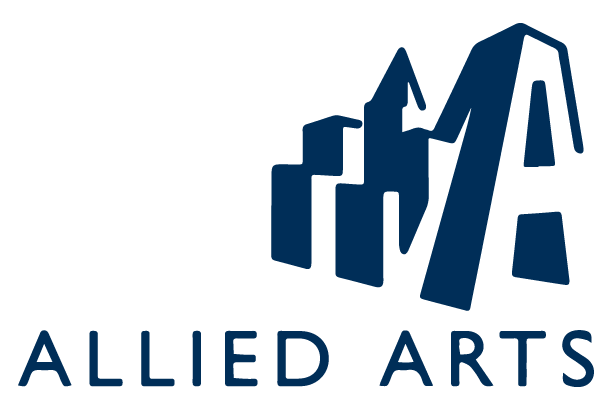
Who We Are
About Us
Allied Arts of Seattle advocates for public funding of the arts, better urban planning and architecture, and other civic improvements
Allied Arts of Seattle is one of the city's most influential advocates for urban design and the arts. The organization grew out of the Beer & Culture Society, a small circle of academics, architects, and artists who first met in early 1952. On October 3, 1954, they convened a Congress of the Arts that established Allied Arts as a permanent organization to advocate for public funding of the arts, better urban planning and architecture, and other civic improvements. Allied Arts has since played leadership roles in promoting the creation of the Seattle Arts Commission; the development of Seattle Center; the preservation of Pike Place Market, Pioneer Square, and other historic landmarks; and other causes.
Beer & Culture Society
In early 1952, University of Washington drama professor John Ashby Conway invited colleagues Lloyd Schram and Robert Dietz, assistant Seattle Art Museum Director Dr. Sherman Lee (1918-2008), and architect John Stewart Detlie, to join him at his home for a discussion of the state of Seattle's arts and urban environment. The resulting "Beer & Culture Society" convened a "Congress of the Allied Arts" on October 3, 1954, which established Allied Arts of Seattle as a permanent advocacy group and elected Detlie as its first president.
The organization formally incorporated after a second Congress in 1955. By the following year, it represented 57 local arts organizations and 55 leading artists and activists, including Kenneth Callahan, George Tsutakawa, and Lucile McDonald.
The new group prevailed on Mayor Allan Pomeroy (ca. 1907-1966) and the City Council to create a Municipal Arts Commission on August 1, 1955. This advisory body in turn recommended a sweeping 35-point master plan on June 23, 1956. Among other reforms, the new plan proposed dedicating 2 percent of city capital funds to purchase art works; staging an annual city arts festival; hosting a world's fair; public funding for the Seattle Symphony; creating Ballet and Opera companies; burying public utility lines; preserving historic landmarks; and planting street trees. The group also campaigned for a State Arts Commission and the prohibition of billboards.
Building Seattle Center, Saving Landmarks
One of the first products of Allied Arts and the new Art Commission was a campaign for a new civic center. Seattle voters approved $7.5 million in public bonds in November 1956 to upgrade the existing Civic Auditorium (now Opera House), which laid the financial foundation for the Seattle World's Fair six years later. Robert J. Block played a major role in these efforts, and he later guided creation of the Allied Arts Foundation, which funds small art projects and arts groups.
In the 1960s, Allied Arts shifted its attention to protection of Seattle's dwindling inventory of historic landmarks. It played leadership roles in the creation of the Pioneer Square Historic District in 1969 and the Seattle Landmarks Preservation Board in 1970, and in passage of a 1971 initiative to preserve Pike Place Market. Allied Arts also championed creation of the Seattle Design Commission to guide municipal architecture.
Major architects such as Victor Steinbrueck, Fred Bassetti, and Ibsen Nelsen were key leaders in this period, and Alice Rooney served as Allied Arts "secretary" and manager. Other Allied Arts activists included Jerry Thonn, Peggy Golberg, Lew Pritchard, Alf Collins, and Rae Tufts.
Coming Full Circle
In the early 1970s, Allied Arts president Paul Schell (1937-2014) led a successful effort to replace the Municipal Art Commission with a stronger Seattle Arts Commission and to reserve 1 percent of city capital budgets for the purchase of public art. Under the leadership of Margaret Pageler and Peter Steinbrueck, Allied Arts concentrated on urban design issues during much of the 1980s, including a new downtown Seattle comprehensive plan in 1985 and passage of the Citizens Alternative Plan (CAP) to limit downtown building heights in 1989. It also advocated funding and zoning changes to promote artists' housing and conversion of facilities at the former Sand Point Naval Air Station to house studios and cultural activities.
Following the demolition of the landmark Music Hall Theater in January 1992, Allied Arts campaigned for stronger historic preservation laws and creation of transferable development rights (TDRs) to protect remaining downtown theaters. Passage of this legislation in 1992 contributed to restoration of the Paramount Theater and other threatened downtown landmarks. Key Allied Arts leaders in this period included Mia McEldowny, Karen Kane, Walt Crowley, and Clint Pehrson.
Also during the 1990s, Allied Arts took controversial positions criticizing the Seattle Commons Plan and opposing a local bid to host the 2012 Olympic Games. In May 1999, Allied Arts president Alex Steffen convened a "Constitutional Convention" of artists and groups to press for new reforms in the way Seattle supports its arts community, thus bringing the organization full circle to its original agenda of almost half a century earlier.




